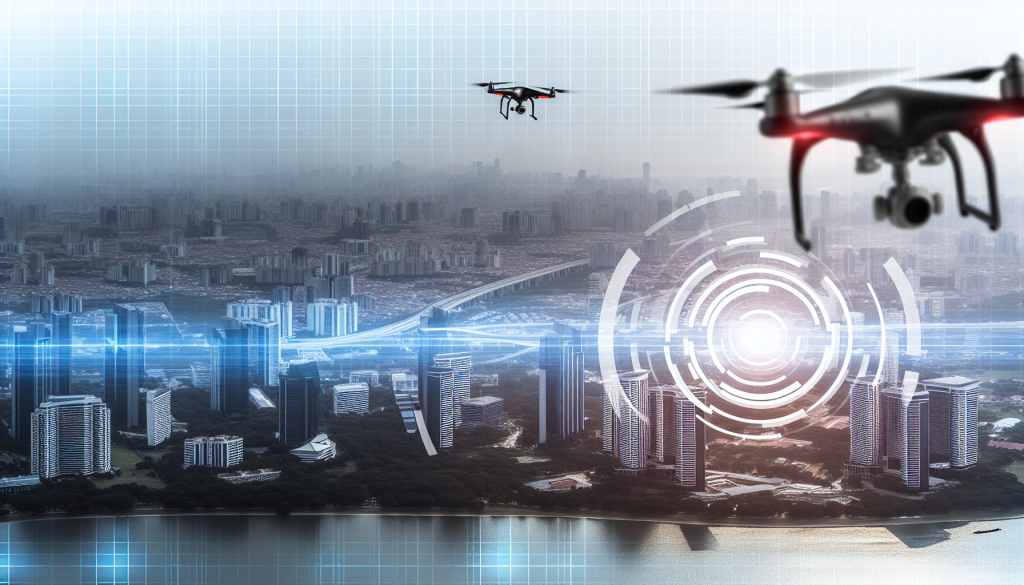ZeroEyes Demonstrates Threat Detection System at AF Base
By DRONELIFE Features Editor Jim Magill
A recent summer concert at a U.S. Air Force base in South Carolina became a pivotal testing ground for innovative drone-based security technologies. The spotlight was on a real-time threat detection and early warning system developed by ZeroEyes, a company renowned for its expertise in gun detection. Under the banner of ZE Government Solutions (ZEGS), the demonstration showcased a sophisticated security solution designed to enhance the safety of large gatherings.
Launching the ZeroEyes Awareness Kit (ZAK)
On August 16, during the Summer Fest Concert at Joint Base Charleston, ZEGS deployed its cutting-edge technology aboard a tethered drone. The setup, known as the ZeroEyes Awareness Kit (ZAK), was aimed at enhancing security protocols while also catching the eye of potential clients within the U.S. Department of Defense and various civilian law enforcement agencies. Dustin Kisling, the Executive Vice President of ZEGS, emphasized the technology’s transformative abilities during a detailed interview.
“Developing this technology really augments a lot of the drone programs that agencies are already looking at implementing,” Kisling remarked. This proactive security solution is not merely reactive; it serves as a “force multiplier,” enabling enhanced monitoring and response capabilities.
Rapid Deployment and System Capabilities
Setting up the ZAK system was impressively efficient, taking less than 30 minutes for ZEGS to operationalize its overwatch capabilities. Mounted on an Easy Aerial tethered drone, ZAK operated using advanced computer-vision software intended to work in tandem with base security forces. This concert marked a crucial point in the technology’s evolution, being its first deployment for real-time security in a real-world environment since its inception in the Air Force Research Laboratory’s Small Business Innovation Research (SBIR) Program.
The system focused on monitoring unauthorized personnel or the presence of firearms near sensitive areas, including the active flight line. “We’re looking for guns, we’re looking for people, we’re looking for the vehicles that shouldn’t be in that area,” Kisling noted. The flexibility of the system allows it to be configured based on specific threats, adapting to different scenarios as needed.
Collaborative Efforts for Enhanced Security
During the concert, ZEGS maintained close coordination with base security personnel to ensure swift responses to any detected anomalies. The drone’s feed was continuously analyzed, and once a potential threat was identified, alerts were promptly communicated to a localized operations center set up at the command post.
ZAK’s performance during the event was notable. For six continuous hours, it provided aerial overwatch, ensuring the safety of over 1,000 base personnel and their families. While this operational test primarily focused on a recreational event, ZAK is designed for broader applications, offering essential security for C-17 crews operating from the base.
Broader Applications and Future Prospects
Beyond its impressive capabilities for on-base security, ZAK’s technology can be utilized in various operational scenarios, including downrange missions that require additional aircrew security in emergency or austere environments. The successful demonstration at Joint Base Charleston is viewed as a stepping stone in the company’s strategy to market the ZAK system to the Department of Defense for broader deployment in the future.
Kisling highlighted how the military’s growing awareness and need for drone-based systems spurred the deployment of ZAK. “Developing this as part of the AFRL program was step one,” he explained, emphasizing the ongoing collaboration with military stakeholders. The support of organizations like Palmetto Spark, the innovation lab for Joint Base Charleston, facilitated the effective use of ZAK during this live event.
Military Initiatives and the Future of Drone Technology
The deployment of ZeroEyes’ technology aligns with larger military initiatives aimed at rapidly expanding the use of small unmanned aerial systems across various branches of the U.S. Armed Forces. This strategic direction was underscored by a memo from Secretary of Defense Pete Hegseth, which described small drone systems as “critical force enablers” that deserve prioritization alongside major weapons systems.
Kisling stressed that the military’s focus on drone technologies transcends merely increasing their inventory; it’s about harnessing analytics to enhance threat detection capabilities. “As you apply analytics to drones, you’re magnifying the ability of these programs to be proactive,” he remarked. This innovative edge is where ZeroEyes plays a crucial role, not only for the DoD but also for civilian law enforcement agencies seeking to revamp their drone programs.
Growing Interest in Civilian Applications
The response to ZAK’s capabilities has been optimistic, attracting interest from various civilian law enforcement agencies. As police forces across the nation increasingly look to establish or upgrade existing drones as dynamic first responders, the relevance of ZeroEyes’ technology continues to rise.
The innovative application of drone technology in enhancing security protocols is gaining momentum, reflecting a broader shift towards integrating advanced analytics and real-time threat detection in both military and civilian domains.

